
| 1997 1998 1999 2000 2001 Hilites | Page 1 - 2 - 3 - 4 - 5 - 6 - 7 - 8 - 9 |
ALFARDA TABLET
|
On February 19 a carved stone tablet with a hieroglyphic text was found on the west alfarda of the uppermost stairway of Temple XIX.
(Click here for a plan of Temple XIX showing the location of the find.) The tablet was found in fragments just below the partially destroyed remains of a stone frame attached to the alfarda that was apparently constructed to display the tablet. The alfarda and the tablet were probably struck and fragmented by heavy stones during the collapse of the structure. A local group of young Maya-Lacandon were the first to visit the area of excavation where the inscription was found. The photograph on this page records the first time in over a thousand years that a Maya had set the eyes on the inscription. This group of Maya-Lacandon have a great interest of learning about their mother culture. Approximately one half of the tablet was recovered intact, and four other fragments that join together were found nearby. Together these fragments represent about two thirds of the original text. The tablet is 0.3 m high and, based on the size of the receptacle, its maximum length was 1.2 m long. Preliminary reconstruction drawing of glyph block. Though somewhat weathered, the tablet is in fair to good condition and most of the partial text can be read. Six glyph blocks are intact on the larger fragment and two and a half on the smaller fragments. Though the smaller fragments do not physically join with the larger fragment, the information in the glyphic text strongly indicates that all of these fragments were originally joined together. Preliminary reconstruction drawing of glyph fragments. The following is a summery of initial comments by our project epigrapher, Dr. David Stuart, and by Alfonso Morales: The text begins with a personal name, "yo-?-? TAL", that unfortunately is difficult to read, but continues with an important office title "Y-Ajaw-K'ak", translated by Dr. Stuart as "Lord of Fire". (Lower case letters in these transcriptions equate with phonetic glyphs, and upper case with logographs.) Dr. Stuart also notes that this title probably has military associations and that it appears several times at Palenque, for example on the Slaves Tablet and on an inscribed stone censer with portrait in the Palenque Museum. This title applies to the personal name that opens the text and Dr. Stuart speculates that he might be a subordinate figure to the ruler. The text continues with a distance number of 876 days forward from the implied 9.15.0.0.0 Katun ending leading to 9 Kib 19 Kayab (January 22, 734 A.D.). This may be the dedication date of Temple XIX as it is followed by the "enters the dwelling house" verb on the smaller joined fragments. The next glyph, the last on the large fragment, is apparently CHAK-?-NAH-hi for "Red or (Great) [something] Building". Following this, on the smaller joined fragments, is a glyph that is difficult to read, but begins with an U and the last sign is an IL, with the intervening signs possibly ?-pi-hi. This is a parallel to the term 'u-pib-nah-il ("its oven house") which may refer to a different type of building "owned" by a god or person named in later glyphs. One of the small fragments has a second partial date, 3 Uyeb. This date almost certainly occurred 24 days later on 7 Ahaw 3 Uyeb 9.15.2.9.0 (February 13, 734 A.D.). We are able to confidently reconstruct this partial date because of an unusual but distinct pattern of dates that connects these new dates with the three earlier dates from the text on a stucco panel from the jamb of the interior support pier of Temple XIX. As described in last season's report, the three Calendar Round dates associated with the male figure in ceremonial regalia (U Pakal K'inich, or His Shield of the Sun God) on the stucco panel are probably retrospective. The latest of these dates, 9 Ahaw 18 Sek 9.14.2.9.0, is the first katun anniversary (7,200 days) of an important date in the life of K'inich Ahkal Mo' Nab III (9.13.2.9.0). (Project epigrapher David Stuart has recently renamed this ruler based on a new reading of his name glyph. He was formerly known as Akul Anab III and before that Chaacal III.) All of the dates fall between the earliest date and the accession date of K'inich Ahkal Mo' Nab III, both of which are recorded on a jamb in Temple XVIII. The three dates from the stucco panel span a period of 5 Tuns (1800 days). The middle date from the stucco panel is the 9.14.0.0.0 Katun ending, 6 Ahaw 13 Muan. The earlier and later dates occur exactly 900 days before and after the 9.14.0.0.0. Katun ending. Our new dates both continue and elaborate on the pattern noted above. The complete house dedication date from the stone tablet (7 Ahaw 19 Kayab 9.15.2.7.16) occurs 876 days after the 9.15.0.0.0 Katun ending, falling 24 days short of continuing the pattern noted above. However, the very next 3 Uyeb (our partial date) after this date happens to occur 24 days later, on 7 Ahaw 3 Uyeb 9.15.2.9.0, the first Katun anniversary of the last date on the stucco panel and second Katun anniversary of the important date from the life of K'inich Ahkal Mo' Nab III from Temple XVIII. Moreover, the house dedication date from the stone tablet is separated from the last date of the Stucco panel by exactly 243 lunar months. At Palenque, during the Classic Period, 2,392 days were equated with 81 lunar months; producing an extremely accurate lunar month of 29.5308... days. Because 3 times 81 lunar months equals 243 lunar months, the moon on both these dates was in exactly the same phase at exactly the same time of day (or night); a situation that occurs only once every 2,392 days. In this light, it is interesting to note that the pre-accession date and the accession date of K'inich Ahkal Mo' Nab III on the jamb of Temple XVIII, are separated by 338 lunar months to the nearest whole day. The three dates from the stucco panel on Temple XIX occur between 7 to 12 years before the accession of K'inich Ahkal Mo' Nab III, and the dates from the new stone tablet occur about 12 years after. All of the dates are apparently linked calendrically to an earlier important date in the life of K'inich Ahkal Mo' Nab III. These criteria, along with the "Head Prince or Heir to the Throne" glyph on the stucco panel, all seem to point to K'inich Ahkal Mo' Nab III as the subject of these texts.
However, K'inich Ahkal Mo' Nab III is not mentioned by name in either of the new texts found in structure XIX. Instead, the name or title U Pakal K'inich (His Shield of the Sun God) is mentioned on the stucco panel, and the personal name "Yo-?-? Tal" and office title "Y-Ajaw-K'ak" (Lord of Fire), are mentioned on the stone tablet. It is not unusual for a Maya king to take on new titles after acceding to the throne, and "Yo-?-? Tal" the "Y-Ajaw-K'ak", Lord of Fire, might be a military leader subordinate to a king.
|
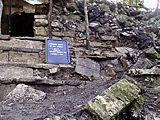
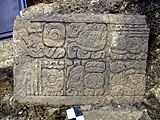
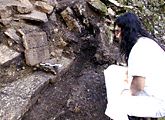
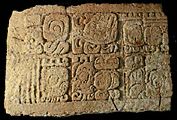

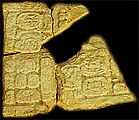
more photos in Archive |
